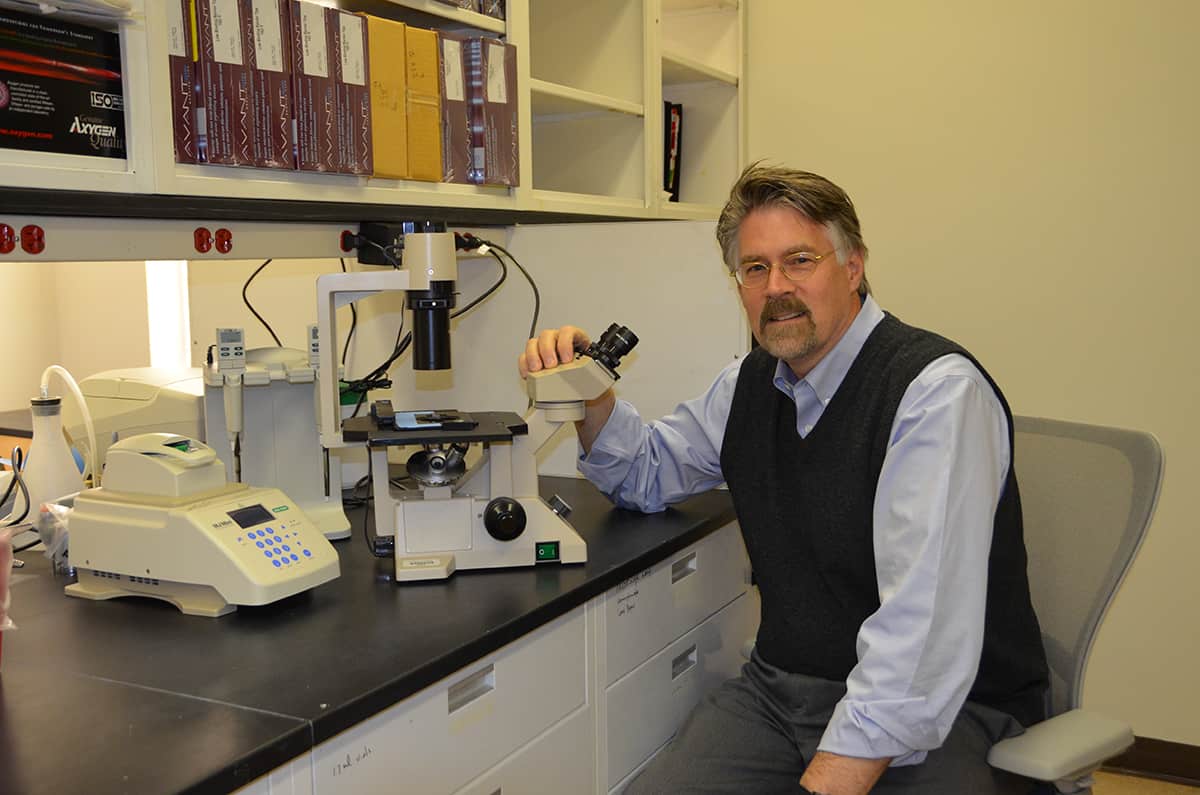View Larger Image

Donald J. Johann, M.D., a lung cancer researcher at the UAMS Winthrop P. Rockefeller Cancer Institute, has been a contributing member of BloodPAC for three years.
Image by Susan Van Dusen
UAMS Lung Cancer Researcher Contributes to Publication of Validation Protocols for Liquid Biopsy to Detect Cancer
| Donald J. Johann, M.D., a lung cancer researcher at the Winthrop P. Rockefeller Cancer Institute at the University of Arkansas for Medical Sciences (UAMS), played an integral role in the publication of research related to liquid biopsy tests, or blood tests, for cancer.
The article titled “Generic Protocols for the Analytical Validation of Next-Generation Sequencing-Based ctDNA Assays: A Joint Consensus Recommendation of the BloodPAC’s Analytical Variables Working Group” was published in the September 2020 issue of Clinical Chemistry by the Blood Profiling Atlas in Cancer Consortium (BloodPAC).
BloodPAC is a national group focused on speeding up the development and validation of liquid biopsy tests to improve the outcomes of patients with cancer.
Johann has been a contributing member of the BloodPAC Analytical Variables Protocols Working Group since its formation three years ago.
“For the last 50 years, the holy grail of cancer research has been the ability to detect the presence of cancer with a simple blood test, known as a liquid biopsy. This is important since many cancer patients are elderly and often in poor health, and traditional invasive biopsies can lead to complications or death. A liquid biopsy is based on a routine blood draw and is safe, fast and less expensive compared to traditional invasive biopsies,” said Johann, associate professor in the departments of Biomedical Informatics and Internal Medicine in the UAMS College of Medicine.
Developed by BloodPAC members, the published resource serves as set of generic analytical protocols and helps to define industry standards in the development of liquid biopsy tests.
“Validation of liquid biopsies pose challenges, primarily due to the extremely small amount of target DNA or RNA in each tube of blood,” Johann said.
The publication contains five standard methods and 12 protocols providing guidance on different aspects of validation studies, including limits of detection, accuracy and contrived sample functional characterization. The protocols were developed with input from the FDA through the official pre-submission process.
“BloodPAC was formed to yield exactly this type of outcome,” said Lauren Leiman, executive director of BloodPAC. “These protocols define rigorous scientific standards for circulating tumor tests and sets a common playing field that will accelerate the cycle of innovation – through development, approval and clinical use – to yield better outcomes for patients.”
The Arkansas Research Alliance (ARA) was instrumental in obtaining funding for Johann’s work.
“In its mission to bring job-creating research to Arkansas, the ARA, working with Dr. Johann, obtained and administered funding for this project from the National Center for Toxicological Research and its parent organization, the Food and Drug Administration. That effort has resulted in over $3.5 million made available for this project in Arkansas,” said Art Norris , ARA project manager.
BloodPAC is a nonprofit consortium managed by the Center for Computational Science Research, Inc. (CCSR), which is an Illinois-based not-for-profit corporation. Today, over thirty organizations have pledged support by contributing liquid biopsy data, protocols, and expertise into an open data commons.
In addition to UAMS, BloodPAC participants include: American Cancer Society (ACS), Association for Molecular Pathology (AMP), AstraZeneca, Bio-Rad, Breast Cancer Research Foundation (BCRF), Bristol Myers Squibb Company, The Center for Genetic Medicine Research at Children’s National Medical Center (CNMC), Ceres Nanosciences, Inc., College of American Pathologists (CAP), Eli Lilly and Company, Epic Sciences, The Food and Drug Administration (FDA), Foundation Medicine, Freenome, Friends of Cancer Research, Guardant Health, Horizon Discovery, Illumina, Inivata, Memorial Sloan Kettering Cancer Center, Movember Foundation, National Cancer Institute (NCI), Novartis, Open Commons Consortium (OCC), Personal Genome Diagnostics (PGDx), Pfizer, Prostate Cancer Foundation (PCF), Prostate Cancer Clinical Trials Consortium (PCCTC), Seracare Life Sciences Inc., SolveBio, Streck, Inc., Sysmex Inostics, Tempus, Thermo Fisher Scientific, University of Chicago, University of Southern California, Department of Veterans Affairs (VA), Windber Research Institute.
UAMS is the state’s only health sciences university, with colleges of Medicine, Nursing, Pharmacy, Health Professions and Public Health; a graduate school; a hospital; a main campus in Little Rock; a Northwest Arkansas regional campus in Fayetteville; a statewide network of regional campuses; and eight institutes: the Winthrop P. Rockefeller Cancer Institute, Jackson T. Stephens Spine & Neurosciences Institute, Harvey & Bernice Jones Eye Institute, Psychiatric Research Institute, Donald W. Reynolds Institute on Aging, Translational Research Institute, Institute for Digital Health & Innovation and the Institute for Community Health Innovation. UAMS includes UAMS Health, a statewide health system that encompasses all of UAMS’ clinical enterprise. UAMS is the only adult Level 1 trauma center in the state. UAMS has 3,485 students, 915 medical residents and fellows, and seven dental residents. It is the state’s largest public employer with more than 11,000 employees, including 1,200 physicians who provide care to patients at UAMS, its regional campuses, Arkansas Children’s, the VA Medical Center and Baptist Health. Visit www.uams.edu or uamshealth.com. Find us on Facebook, X (formerly Twitter), YouTube or Instagram.###